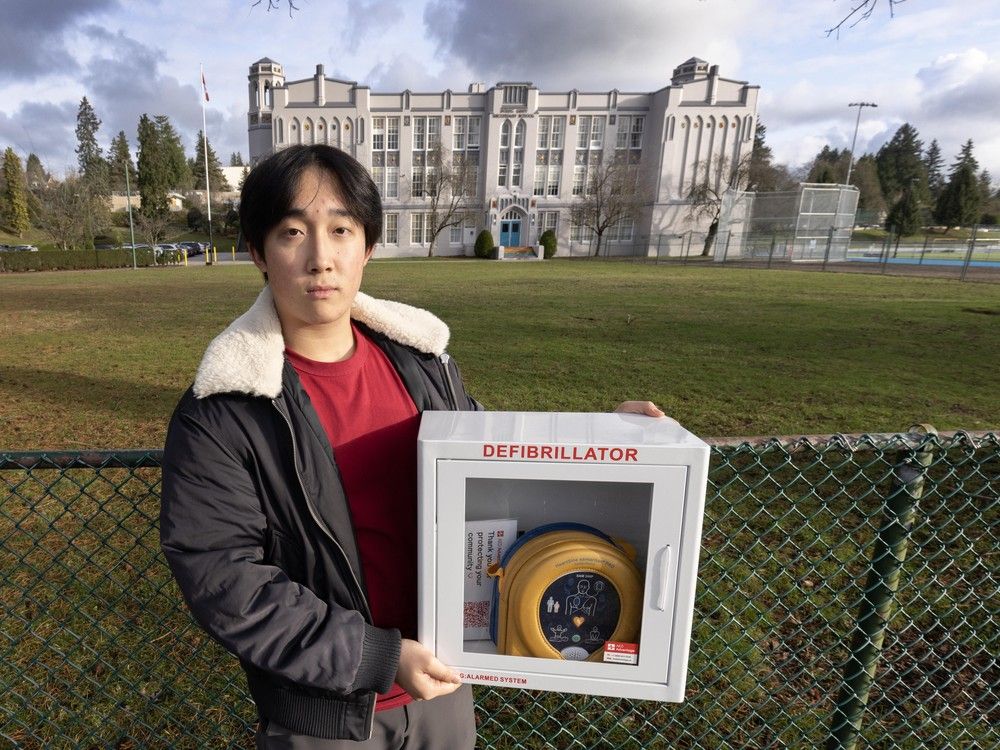
All Grade 10 students will learn first aid in gym class starting in September, and every B.C. school will be required to have medical kits to treat cardiac arrests and reverse overdoses.
These significant Ministry of Education policy changes are the direct result of persistent advocacy by a group of Vancouver high schools students who watched their friend die from cardiac arrest , as well as from the parents of a University of Victoria student who didn’t get the help she needed after being poisoned by toxic drugs.
“That’s cool to hear. That’s really great,” Tobias Zhang, who is going into Grade 12 at Point Grey Secondary, said Monday when told about the changes.
“It makes me feel like I can rest a little bit easier now. It’s nice to know that this device will be in schools, and we’ll all be a little bit safer in school.”
Zhang and several of his classmates began lobbying last year for automated external defibrillators, or AEDs, for their school after his best friend collapsed during a Grade 9 basketball tryout in 2022. The 911 operator told the students to find an AED, but the school didn’t have one.
The ministry confirmed that performing CPR and using AEDs will now be part of the Grade 10 physical education curriculum at public and private schools when classes resume this fall, so “every student will have the opportunity to gain these life-saving skills.”
A ministry email said a ministerial order covering support services in schools was amended last month to make having AEDs and overdose-reversing naloxone kits mandatory. The two medical devices must be in all secondary schools before the end of 2025, and in elementary and middle schools by September 2026, the ministry says.

The jury at a coroner’s inquest into last year’s preventable overdose death of UVic student Sidney McIntyre-Starko recommended in May that secondary schools should teach CPR and administering naloxone. Sidney’s parents, Ken Starko and emergency room physician Dr. Caroline McIntyre, have created a public campaign to push for similar changes.
On Monday, McIntyre applauded the policy adjustments. But she wishes information about the lethal drug supply and how to reverse overdoses would also be taught in classrooms, since toxic drugs are the leading cause of death for British Columbians ages 10 to 59.
“We are grateful that CPR and AED training will be part of the curriculum. Every child deserves to learn these basic, life-saving skills,” she said.
“I hope they include education about the toxic drug crisis, how to respond to an overdose, as well as naloxone training.”

Melanie Cheng, president of the Vancouver District Parent Advisory Council, said the changes were long overdue.
“It’s become an industry standard to have an AED at a recreation facility. Why not a school site,” she asked.
“It shouldn’t be an option for districts. It should be mandatory. These are critical life skills that students need.”
Vancouver school trustee Christopher Richardson backs the CPR, AED and naloxone requirements, but wonders why the province didn’t institute them earlier. “Let’s not wait until a coroner’s inquest demands this,” said Richardson, who supported the students’ AED efforts.
Last year, the Vancouver school board rebuffed the students’ AED requests, based on advice from Vancouver Coastal Health that the devices were only necessary in schools with children with existing health conditions. The board made this call despite the fact many other districts already had AEDs in their buildings.
In January, though, the board reversed course and asked the province for $250,000 to buy AEDs for all 107 schools .
The new provincial directives, though, do not come with funding, so the Vancouver district will have to find the money for the AEDs, Richardson said.
“I was gravely disappointed,” he said. “When they mandated (these changes), there was no funding. And they made that very clear.”
Zhang and his friends have raised nearly $14,000 to help Vancouver school buy AEDs. Zhang said being part of the solution made him feel like he and his friends accomplished something important.

While CPR and AED training are meaningful skills, what is more relevant to young people is giving them naloxone kits and training to use them, added Richardson, who is a special constable with the Vancouver police.
“Having free and easy access to nasal naloxone would improve intervention outcomes even more,” agreed Starko, Sidney’s father.
“And we hope for increased government action against import of unregulated drugs and their component chemicals.”
B.C.’s toxic drug crisis has claimed more than 16,000 lives since it was declared a provincial health emergency in 2016.
When Sidney overdosed in a UVic residence, student witnesses immediately called 911 and campus security, who have first aid training. But she died of oxygen deprivation after not getting naloxone for 13 minutes and CPR for 15 minutes.
Related
For more health news and content around diseases, conditions, wellness, healthy living, drugs, treatments and more, head to Healthing.ca – a member of the Postmedia Network.